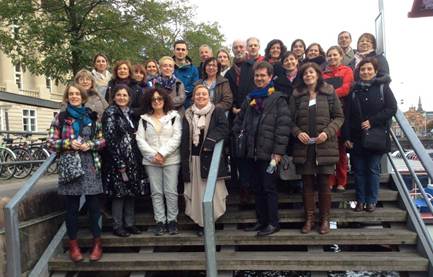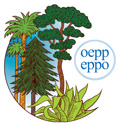
19th Meeting of the EPPO Panel on Diagnostics in Bacteriology
Copenhagen (DK), 2015-10-20/22
The Panel was hosted by the Danish Agrifish Agency-Ministry of Food, Agriculture and Fisheries (NPPO, DK). The Panel continued its task of developing diagnostic protocols for regulated bacterial plant diseases, and was followed by a meeting of the European Association of Phytobacteriologists (EAP).

General discussions
The Panel was informed about the outcomes of recent meetings and Workshops of relevance to diagnostics in Bacteriology. An update was provided in particular on the IPPC programme for developing diagnostic protocols (with the different levels of consultation organized by the IPPC Secretariat) and on the preparation of a discussion paper on the approach to Guidelines on flexible scope in plant health currently being discussed with the European co-operation for Accreditation (EA). The Panel also noted that a revision of the EPPO Standard PM 7/76 Use of EPPO Diagnostic protocols is being prepared. The Panel discussed the inclusion of commercial kits (e.g. for PCR) in EPPO diagnostic protocols and the minimum criteria (in terms of information required) for inclusion of these kits.
Discussions on pest-specific diagnostic protocols
IPPC protocols
The EPPO Secretariat reminded the experts of the importance to review of IPPC protocols sent for consultation. In order to ensure more efficient participation of EPPO experts in the review of IPPC diagnostic protocols, it was agreed to identify a group of experts to review each IPPC protocol. In this framework, a small group of experts will work under the coordination of the EPPO Secretariat to finalise the regional comments for the diagnostic protocols on Xanthomonas fragariae.
Experts of the Panel were also encouraged to provide comments on the IPPC diagnostic protocol on ‘Candidatus Liberibacter solanacearum’ which was posted for expert comments.
EPPO protocols under revision
Because of the emergency situation represented by the outbreaks of Xylella fastidiosa in Italy and France, a special session (view presentations below) was held in order to gather information on the different tests used for the detection and identification of the bacterium in EPPO countries; a review of the tests described in the literature was also presented. Information from the presentations was used to help decide on the tests to be included in the revised Standard PM 7/24. An Expert Working Group will be convened at EPPO Headquarters on 2016-01-12/13 to allow experts to work on the revised diagnostic protocol.
Pantoea stewartii subsp. stewartii. The Panel reviewed the comments made during country consultation on the proposed revision of the diagnostic protocol on Pantoea stewartii subsp. stewartii and in particular about the need to include two conventional PCR tests using the same primers, as one shows a lower analytical sensitivity. The Panel noted that the conventional PCR showing a lower sensitivity was published (the other is not published) and can be used when a sufficient amount of pure culture is produced (a note will be added to that effect). The Panel agreed that the text was ready to be sent for the final stage of the approval procedure.
Clavibacter michiganensis subsp. michiganensis. The Panel also discussed the comments received on the EPPO diagnostic protocol on Clavibacter michiganensis subsp. michiganensis. The Standard describes two procedures for the detection and identification of the bacterium in seed samples, which are currently being evaluated for equivalence following an interlaboratory comparison; the results and analysis of the comparison should be available soon and the EPPO Secretariat will wait for these results before sending the EPPO diagnostic protocol for the final stage of the approval procedure.
Ralstonia solanacearum, a first draft revision of this protocol was presented and Panel members volunteered to provide information on different test and a revised text should be prepared for the next meeting of the Panel.
EPPO protocols under development
The Panel agreed that with the last amendments made by the authors the Diagnostic Protocol on Xanthomonas axonopodis pv. allii should be sent for Country Consultation
A diagnostic protocol on Acidovorax citrulli is currently under development. Most of the work on test development and validation has been performed in the framework of the EU FP7 project TESTA (Seed health: development of seed treatment methods, evidence for seed transmission and assessment of seed health). Although TESTA focussed on seeds, the EPPO protocol also covers detection and identification in plant material. The Panel considered that the Protocol should be sent for Country Consultation in early 2016.
The EPPO diagnostic protocol on ‘Candidatus Liberibacter solanacearum’ was also reviewed. The Panel discussed in particular the need to include the recommendation to perform a propidium monoazide (PMA) treatment before PCR in order to distinguish between viable and non-viable cells in particular for asymptomatic matrices such as seeds. The Panel agreed that a note should be added to the protocol explaining that PMA treatment was not included in the Standard because of the lack of validation data. The protocol should be sent for Country Consultation as soon as a revised version including suggestions made at the meeting is provided to the EPPO Secretariat.
Update on new activities within EPPO
The Euphresco network, hosted within EPPO since June 2014 was presented, with a special focus on the Common Strategic Research Agenda, a document setting out Euphresco members’ shared vision of phytosanitary research in the medium term (5-10 years). The Common Strategic Research Agenda now needs to be updated to reflect changes in the European regulatory context, new phytosanitary risks and new opportunities for research to deliver effective risk management tools.
An update concerning the Q-collect project was given during the European Association of Phytobacteriologists (EAP) meeting. Guidelines on quality assurance for reference collections elaborated during the project were presented. It was noted that these should be further developed in the framework of the EPPO specialized Panels on diagnostics for each group of organisms. The final objective is to prepare an EPPO Standard to provide guidance on quality assurance for reference collections. Criteria for the establishment of a sustainable network were described and plans for an online platform to stimulate and facilitate networking and data sharing were presented.
The next meeting will be held in Paris in 2016-06-1/2.
European Association of Phytobacteriologists (EAP)
 The European Association of Phytobacteriologists (EAP) was set up early 2007 by expert phytobacteriologists from eight EU Member States to encourage co-operation in the field of diagnosis, detection, identification and classification of bacterial plant pathogens. The association aims specifically at phytobacteriologists from (government) laboratories, agencies or institutions, who are consistently involved in diagnosis and testing. A Charter of Foundation was elaborated and approved by the EAP Executive Committee on 5 February 2007. An amended charter was ratified by the EAP Executive Committee on 28 October 2008. The objectives of the EAP are: development, improvement and implementation of diagnosis, detection, identification and classification of bacterial plant pathogens education and training in principles and practice of phytobacteriology provision of advice and expertise to plant health regulatory bodies promotion of technical and scientific collaboration exchange of information through communication networking.
The European Association of Phytobacteriologists (EAP) was set up early 2007 by expert phytobacteriologists from eight EU Member States to encourage co-operation in the field of diagnosis, detection, identification and classification of bacterial plant pathogens. The association aims specifically at phytobacteriologists from (government) laboratories, agencies or institutions, who are consistently involved in diagnosis and testing. A Charter of Foundation was elaborated and approved by the EAP Executive Committee on 5 February 2007. An amended charter was ratified by the EAP Executive Committee on 28 October 2008. The objectives of the EAP are: development, improvement and implementation of diagnosis, detection, identification and classification of bacterial plant pathogens education and training in principles and practice of phytobacteriology provision of advice and expertise to plant health regulatory bodies promotion of technical and scientific collaboration exchange of information through communication networking.
The main activities of EAP to achieve its objectives are:
- to develop, standardise, review, update and validate existing and new diagnostic methods and procedures for regulated and non-regulated bacterial plant pathogens
- to organise test performance studies, proficiency tests and method validations
- to organise workshops on specific topics
- to identify possibilities for collaborative research
- to share access to data bases e.g. culture collections, nucleic acid sequences, antibodies, validated test protocols
- to construct and maintain a website
- to release a newsletter
- to establish and maintain a discussion forum
- to hold an annual meeting organised by one of the members on the basis of country rotation
The Chair of the EAP is J.D. Janse, phytobacteriologist at the General Inspection Service (NAK), The Netherlands. The EAP Secretariat is held by J. Van Vaerenbergh, phytobacteriologist at the Institute for Agricultural and Fisheries Research (ILVO), Belgium.
The first regular meeting of the EAP was in 2009 in conjunction with the EPPO Panel on Diagnostics in Bacteriology and joint meetings have been held since then.
6th EAP meeting 2015
Various members of EAP presented work of importance to their colleagues.
Pest-specific work
Ms Lopez (IVIA, Spain) presented work on multilocus variable number of tandem repeats analysis that revealed multiple introductions of Xanthomonas arboricola pv. pruni in Spain, and work on Pseudomonas syringae pv. actinidifoliorum and strains of Pseudomonas syringae with low virulence found in kiwifruit orchards. Mr Stefani (UNIMORE, Italy) gave a presentation on the re-emerging disease bacterial blight of walnut. Ms Poliakoff (Anses, France) presented the latest information on outbreaks of Xylella fastidiosa on Corsica. Ms Bergsma-Vlami gave a talk on Rosa spp: a new host for Ralstonia solanacearum. Ms Leonor Cruz presented Pseudomonas syringae pathovars affecting Actinidia in Portugal. Mr Van Vaerenbergh (ILVO, Belgium) gave talks on natural infection of Clavibacter michiganensis subsp. sepedonicus on tomato and also on interlaboratory test on the identification of non-European strains of Ralstonia solanacearum by TaqMan PCR.
Project outcomes
Mr Giovani presented information on EUPHRESCO activities and a brainstorming session on the Strategic Research Agenda. Mr Elphinstone (FERA, UK) presented the outcomes from the Q-Collect project and role of the Q-Ba-Co network.
Other
The EAP Executive Committee also met after the main meeting.
Additionally, Giovani Baldissera, co-ordinator of the Euphresco network at EPPO ran a brainstorming session on strategic research and Johan Van Vaerenbergh (ILVO, Belgium) briefly presented interlaboratory tests.
| Presentations made during the EAP Meeting | |
| Multilocus variable number of tandem repeats analysis reveals multiple introductions of Xanthomonas arboricola pv. pruni in Spain |
Maria Lopez, IVIA, ES
|
| Pseudomonas syringae pv. actinidifoliorum and strains of Pseudomonas syringae with low virulence found in kiwifruit orchards |
Maria Lopez IVIA, ES
|
| Outcomes from the Q-Collect project and role of the Q-Ba-Co network |
John Elphinstone, FERA, GB
|
| Bacterial blight of walnut: a severely re-emerging disease |
Emilio Stefani, UNIMORE, IT
|
| Outbreaks of Xylella fastidiosa on Corsica |
Françoise Poliakoff, Anses, FR
|
| Rosa spp: a new host for Ralstonia solanacearum |
Maria Bergsma-Vlami, NL
|
| Pseudomonas syringae pathovars affecting Actinidia in Portugal |
Maria Leonor Cruz, INIAV, PT
|
| Natural infection of Clavibacter michiganensis subsp. sepedonicus on tomato |
Johan Van Vaerenbergh, ILVO, BE
|
